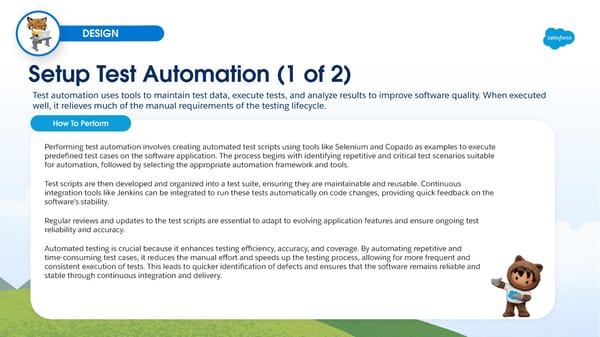2 DESIGN Setup Test Automation (1 of 2) Test automation uses tools to maintain test data, execute tests, and analyze results to improve software quality. When executed well, it relieves much of the manual requirements of the testing lifecycle. How To Perform Performing test automation involves creating automated test scripts using tools like Selenium and Copado as examples to execute predefined test cases on the software application. The process begins with identifying repetitive and critical test scenarios suitable for automation, followed by selecting the appropriate automation framework and tools. Test scripts are then developed and organized into a test suite, ensuring they are maintainable and reusable. Continuous integration tools like Jenkins can be integrated to run these tests automatically on code changes, providing quick feedback on the software's stability. Regular reviews and updates to the test scripts are essential to adapt to evolving application features and ensure ongoing test reliability and accuracy. Automated testing is crucial because it enhances testing efficiency, accuracy, and coverage. By automating repetitive and time-consuming test cases, it reduces the manual effort and speeds up the testing process, allowing for more frequent and consistent execution of tests. This leads to quicker identification of defects and ensures that the software remains reliable and stable through continuous integration and delivery.
 A Partner Readiness Guide to Deliver Like Salesforce Page 75 Page 77
A Partner Readiness Guide to Deliver Like Salesforce Page 75 Page 77